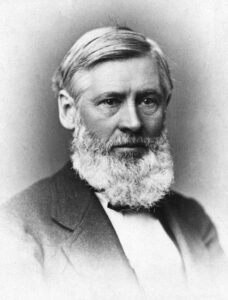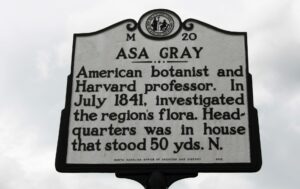Asa Gray
History

Asa Gray (November 18, 1810 – January 30, 1888) is considered the most important American botanist of the 19th century. His Darwiniana was considered an important explanation of how religion and science were not necessarily mutually exclusive. Gray was adamant that a genetic connection must exist between all members of a species. He was also strongly opposed to the ideas of hybridization within one generation and special creation in the sense of its not allowing for evolution. He was a strong supporter of Darwin, although Gray’s theistic evolution was guided by a Creator.
As a professor of botany at Harvard University for several decades, Gray regularly visited, and corresponded with, many of the leading natural scientists of the era, including Charles Darwin, who held great regard for him. Gray made several trips to Europe to collaborate with leading European scientists of the era, as well as trips to the southern and western United States. He also built an extensive network of specimen collectors.
Asa Gray
Marker ID: N18
Google Map
NC Highway Map
Nearest Town: Linville, NC
Date Cast: 1949
Marker Text
N18 – Asa Gray
American botanist and Harvard professor. In July, 1841, investigated flora of this region. He visited Grandfather Mountain.
Essay
Asa Gray, Harvard University professor, and botanist, was born in 1810 in Oneida County, New York, the eldest child of Moses and Roxanna Gray. As a teenager, he attended Fairfield Academy in Herkimer County, where he came under the tutelage of natural scientist James Hadley. Fascinated by the sciences, Grays studied with Hadley at the Fairfield Medical School from 1829 to 1831 after his graduation from the preparatory school. He graduated in 1831 with an M.D. but decided that his life’s work would focus on botany, not human anatomy.
Gray taught at several high schools in New York and New Jersey during the early 1830s, and subsequently took a professorship in botany at Hamilton College in 1834. Four years later he accepted the professorship in botany at the newly formed University of Michigan, and departed for Europe to collect specimens and books for his academic library. Returning to the United States in 1840, he embarked the following year on a research trip into the mountains of North Carolina alongside fellow botanists James Constable and John Carey. Their route followed, in some respects, the path taken by French botanist Andre Michaux six decades previous.
From July 1 to 6, 1841, Gray visited Ashe County, establishing a headquarters in Jefferson. The following week Gray tramped up and down the slopes of Grandfather Mountain near Linville, collecting flora specimens for his collections. From there Gray struck out for Tennessee, passing through Mitchell County to reach Roan Mountain. On July 13 he returned to Jefferson, where he remained for nearly three weeks, cataloging and recording his North Carolina specimens.
The following year, Gray published his Botanical Textbook, which included drawings of several North Carolina plants. It became the model for future science textbooks. That same year Gray turned down the University of Michigan offer in favor to a position at Harvard University and established himself as the leading American botanist.
For the subsequent forty-five years of his life, Gray traveled the world collecting specimens. He published nearly twenty books and articles on botany, helped established the National Academy of Sciences, and served as one of the first regents of the Smithsonian Institution. On Sept. 5, 1857, Charles Darwin wrote Gray a letter in which he first outlined his theory of the evolution of species by means of natural selection and the following year sent him an advance copy of On the Origin of Species. Gray remained a strong supporter of Darwin and his theory for the remainder of his life.
Gray died in 1888 at his home in Massachusetts. The Asa Gray Award, the highest award bestowed by the American Society of Plant Taxonomists is named in his honor as is Gray Peak, a mountain in New York.
References:
- John H. Felts, “Asa Gray in North Carolina: The Beginnings of Botany in the United States,” North Carolina Medical Journal (July/August 2000): 190-192
- A. H. Dupree, Asa Gray, 1810-1888 (1959)
- Jane L. Gray, ed., Letters of Asa Gray (1894)
- Asa Gray, Darwiniana: Essays and Reviews Pertaining to Darwinism (1888)
- Allen Johnson and Dumas Malone, ed., Dictionary of American Biography (1936), VII, 511-514
- William S. Powell, ed., Encyclopedia of North Carolina (2006)
Related Articles
- Gray, Asa (coming soon)

